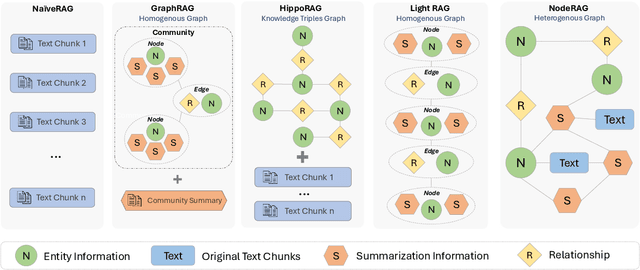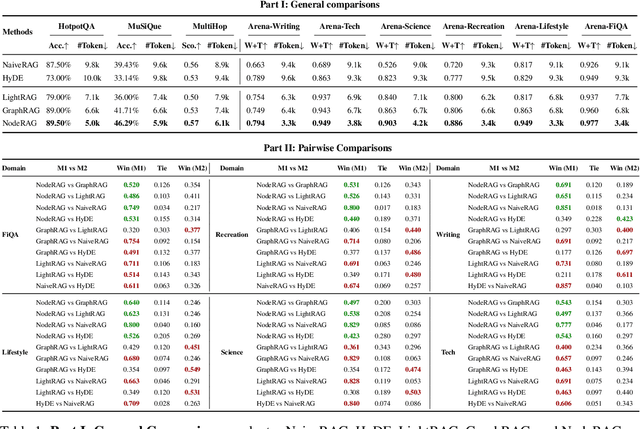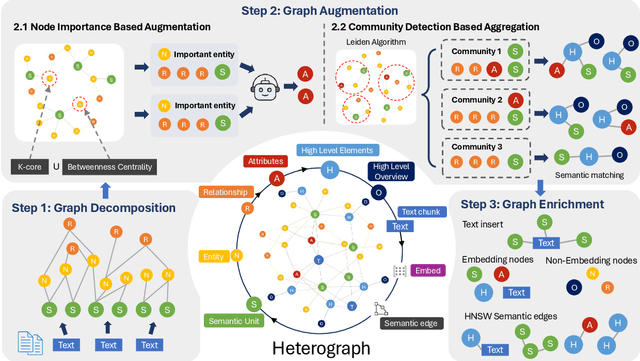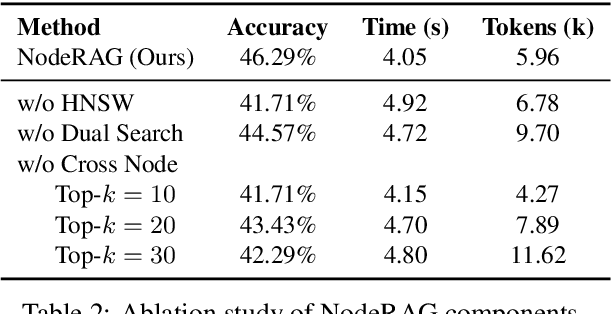Tianyang Xu
Jiangnan University, China
MARS2 2025 Challenge on Multimodal Reasoning: Datasets, Methods, Results, Discussion, and Outlook
Sep 17, 2025Abstract:This paper reviews the MARS2 2025 Challenge on Multimodal Reasoning. We aim to bring together different approaches in multimodal machine learning and LLMs via a large benchmark. We hope it better allows researchers to follow the state-of-the-art in this very dynamic area. Meanwhile, a growing number of testbeds have boosted the evolution of general-purpose large language models. Thus, this year's MARS2 focuses on real-world and specialized scenarios to broaden the multimodal reasoning applications of MLLMs. Our organizing team released two tailored datasets Lens and AdsQA as test sets, which support general reasoning in 12 daily scenarios and domain-specific reasoning in advertisement videos, respectively. We evaluated 40+ baselines that include both generalist MLLMs and task-specific models, and opened up three competition tracks, i.e., Visual Grounding in Real-world Scenarios (VG-RS), Visual Question Answering with Spatial Awareness (VQA-SA), and Visual Reasoning in Creative Advertisement Videos (VR-Ads). Finally, 76 teams from the renowned academic and industrial institutions have registered and 40+ valid submissions (out of 1200+) have been included in our ranking lists. Our datasets, code sets (40+ baselines and 15+ participants' methods), and rankings are publicly available on the MARS2 workshop website and our GitHub organization page https://github.com/mars2workshop/, where our updates and announcements of upcoming events will be continuously provided.
GrFormer: A Novel Transformer on Grassmann Manifold for Infrared and Visible Image Fusion
Jun 17, 2025Abstract:In the field of image fusion, promising progress has been made by modeling data from different modalities as linear subspaces. However, in practice, the source images are often located in a non-Euclidean space, where the Euclidean methods usually cannot encapsulate the intrinsic topological structure. Typically, the inner product performed in the Euclidean space calculates the algebraic similarity rather than the semantic similarity, which results in undesired attention output and a decrease in fusion performance. While the balance of low-level details and high-level semantics should be considered in infrared and visible image fusion task. To address this issue, in this paper, we propose a novel attention mechanism based on Grassmann manifold for infrared and visible image fusion (GrFormer). Specifically, our method constructs a low-rank subspace mapping through projection constraints on the Grassmann manifold, compressing attention features into subspaces of varying rank levels. This forces the features to decouple into high-frequency details (local low-rank) and low-frequency semantics (global low-rank), thereby achieving multi-scale semantic fusion. Additionally, to effectively integrate the significant information, we develop a cross-modal fusion strategy (CMS) based on a covariance mask to maximise the complementary properties between different modalities and to suppress the features with high correlation, which are deemed redundant. The experimental results demonstrate that our network outperforms SOTA methods both qualitatively and quantitatively on multiple image fusion benchmarks. The codes are available at https://github.com/Shaoyun2023.
The Harmonic Structure of Information Contours
Jun 04, 2025Abstract:The uniform information density (UID) hypothesis proposes that speakers aim to distribute information evenly throughout a text, balancing production effort and listener comprehension difficulty. However, language typically does not maintain a strictly uniform information rate; instead, it fluctuates around a global average. These fluctuations are often explained by factors such as syntactic constraints, stylistic choices, or audience design. In this work, we explore an alternative perspective: that these fluctuations may be influenced by an implicit linguistic pressure towards periodicity, where the information rate oscillates at regular intervals, potentially across multiple frequencies simultaneously. We apply harmonic regression and introduce a novel extension called time scaling to detect and test for such periodicity in information contours. Analyzing texts in English, Spanish, German, Dutch, Basque, and Brazilian Portuguese, we find consistent evidence of periodic patterns in information rate. Many dominant frequencies align with discourse structure, suggesting these oscillations reflect meaningful linguistic organization. Beyond highlighting the connection between information rate and discourse structure, our approach offers a general framework for uncovering structural pressures at various levels of linguistic granularity.
Hybrid Batch Normalisation: Resolving the Dilemma of Batch Normalisation in Federated Learning
May 28, 2025Abstract:Batch Normalisation (BN) is widely used in conventional deep neural network training to harmonise the input-output distributions for each batch of data. However, federated learning, a distributed learning paradigm, faces the challenge of dealing with non-independent and identically distributed data among the client nodes. Due to the lack of a coherent methodology for updating BN statistical parameters, standard BN degrades the federated learning performance. To this end, it is urgent to explore an alternative normalisation solution for federated learning. In this work, we resolve the dilemma of the BN layer in federated learning by developing a customised normalisation approach, Hybrid Batch Normalisation (HBN). HBN separates the update of statistical parameters (i.e. , means and variances used for evaluation) from that of learnable parameters (i.e. , parameters that require gradient updates), obtaining unbiased estimates of global statistical parameters in distributed scenarios. In contrast with the existing solutions, we emphasise the supportive power of global statistics for federated learning. The HBN layer introduces a learnable hybrid distribution factor, allowing each computing node to adaptively mix the statistical parameters of the current batch with the global statistics. Our HBN can serve as a powerful plugin to advance federated learning performance. It reflects promising merits across a wide range of federated learning settings, especially for small batch sizes and heterogeneous data.
NodeRAG: Structuring Graph-based RAG with Heterogeneous Nodes
Apr 15, 2025



Abstract:Retrieval-augmented generation (RAG) empowers large language models to access external and private corpus, enabling factually consistent responses in specific domains. By exploiting the inherent structure of the corpus, graph-based RAG methods further enrich this process by building a knowledge graph index and leveraging the structural nature of graphs. However, current graph-based RAG approaches seldom prioritize the design of graph structures. Inadequately designed graph not only impede the seamless integration of diverse graph algorithms but also result in workflow inconsistencies and degraded performance. To further unleash the potential of graph for RAG, we propose NodeRAG, a graph-centric framework introducing heterogeneous graph structures that enable the seamless and holistic integration of graph-based methodologies into the RAG workflow. By aligning closely with the capabilities of LLMs, this framework ensures a fully cohesive and efficient end-to-end process. Through extensive experiments, we demonstrate that NodeRAG exhibits performance advantages over previous methods, including GraphRAG and LightRAG, not only in indexing time, query time, and storage efficiency but also in delivering superior question-answering performance on multi-hop benchmarks and open-ended head-to-head evaluations with minimal retrieval tokens. Our GitHub repository could be seen at https://github.com/Terry-Xu-666/NodeRAG.
SUV: Scalable Large Language Model Copyright Compliance with Regularized Selective Unlearning
Mar 29, 2025Abstract:Large Language Models (LLMs) have transformed natural language processing by learning from massive datasets, yet this rapid progress has also drawn legal scrutiny, as the ability to unintentionally generate copyrighted content has already prompted several prominent lawsuits. In this work, we introduce SUV (Selective Unlearning for Verbatim data), a selective unlearning framework designed to prevent LLM from memorizing copyrighted content while preserving its overall utility. In detail, the proposed method constructs a dataset that captures instances of copyrighted infringement cases by the targeted LLM. With the dataset, we unlearn the content from the LLM by means of Direct Preference Optimization (DPO), which replaces the verbatim copyrighted content with plausible and coherent alternatives. Since DPO may hinder the LLM's performance in other unrelated tasks, we integrate gradient projection and Fisher information regularization to mitigate the degradation. We validate our approach using a large-scale dataset of 500 famous books (predominantly copyrighted works) and demonstrate that SUV significantly reduces verbatim memorization with negligible impact on the performance on unrelated tasks. Extensive experiments on both our dataset and public benchmarks confirm the scalability and efficacy of our approach, offering a promising solution for mitigating copyright risks in real-world LLM applications.
One Model for ALL: Low-Level Task Interaction Is a Key to Task-Agnostic Image Fusion
Feb 27, 2025Abstract:Advanced image fusion methods mostly prioritise high-level missions, where task interaction struggles with semantic gaps, requiring complex bridging mechanisms. In contrast, we propose to leverage low-level vision tasks from digital photography fusion, allowing for effective feature interaction through pixel-level supervision. This new paradigm provides strong guidance for unsupervised multimodal fusion without relying on abstract semantics, enhancing task-shared feature learning for broader applicability. Owning to the hybrid image features and enhanced universal representations, the proposed GIFNet supports diverse fusion tasks, achieving high performance across both seen and unseen scenarios with a single model. Uniquely, experimental results reveal that our framework also supports single-modality enhancement, offering superior flexibility for practical applications. Our code will be available at https://github.com/AWCXV/GIFNet.
UASTrack: A Unified Adaptive Selection Framework with Modality-Customization in Single Object Tracking
Feb 25, 2025



Abstract:Multi-modal tracking is essential in single-object tracking (SOT), as different sensor types contribute unique capabilities to overcome challenges caused by variations in object appearance. However, existing unified RGB-X trackers (X represents depth, event, or thermal modality) either rely on the task-specific training strategy for individual RGB-X image pairs or fail to address the critical importance of modality-adaptive perception in real-world applications. In this work, we propose UASTrack, a unified adaptive selection framework that facilitates both model and parameter unification, as well as adaptive modality discrimination across various multi-modal tracking tasks. To achieve modality-adaptive perception in joint RGB-X pairs, we design a Discriminative Auto-Selector (DAS) capable of identifying modality labels, thereby distinguishing the data distributions of auxiliary modalities. Furthermore, we propose a Task-Customized Optimization Adapter (TCOA) tailored to various modalities in the latent space. This strategy effectively filters noise redundancy and mitigates background interference based on the specific characteristics of each modality. Extensive comparisons conducted on five benchmarks including LasHeR, GTOT, RGBT234, VisEvent, and DepthTrack, covering RGB-T, RGB-E, and RGB-D tracking scenarios, demonstrate our innovative approach achieves comparative performance by introducing only additional training parameters of 1.87M and flops of 1.95G. The code will be available at https://github.com/wanghe/UASTrack.
Learning Structure-Supporting Dependencies via Keypoint Interactive Transformer for General Mammal Pose Estimation
Feb 25, 2025Abstract:General mammal pose estimation is an important and challenging task in computer vision, which is essential for understanding mammal behaviour in real-world applications. However, existing studies are at their preliminary research stage, which focus on addressing the problem for only a few specific mammal species. In principle, from specific to general mammal pose estimation, the biggest issue is how to address the huge appearance and pose variances for different species. We argue that given appearance context, instance-level prior and the structural relation among keypoints can serve as complementary evidence. To this end, we propose a Keypoint Interactive Transformer (KIT) to learn instance-level structure-supporting dependencies for general mammal pose estimation. Specifically, our KITPose consists of two coupled components. The first component is to extract keypoint features and generate body part prompts. The features are supervised by a dedicated generalised heatmap regression loss (GHRL). Instead of introducing external visual/text prompts, we devise keypoints clustering to generate body part biases, aligning them with image context to generate corresponding instance-level prompts. Second, we propose a novel interactive transformer that takes feature slices as input tokens without performing spatial splitting. In addition, to enhance the capability of the KIT model, we design an adaptive weight strategy to address the imbalance issue among different keypoints.
Towards Enhanced Immersion and Agency for LLM-based Interactive Drama
Feb 25, 2025Abstract:LLM-based Interactive Drama is a novel AI-based dialogue scenario, where the user (i.e. the player) plays the role of a character in the story, has conversations with characters played by LLM agents, and experiences an unfolding story. This paper begins with understanding interactive drama from two aspects: Immersion, the player's feeling of being present in the story, and Agency, the player's ability to influence the story world. Both are crucial to creating an enjoyable interactive experience, while they have been underexplored in previous work. To enhance these two aspects, we first propose Playwriting-guided Generation, a novel method that helps LLMs craft dramatic stories with substantially improved structures and narrative quality. Additionally, we introduce Plot-based Reflection for LLM agents to refine their reactions to align with the player's intentions. Our evaluation relies on human judgment to assess the gains of our methods in terms of immersion and agency.
 Add to Chrome
Add to Chrome Add to Firefox
Add to Firefox Add to Edge
Add to Edge